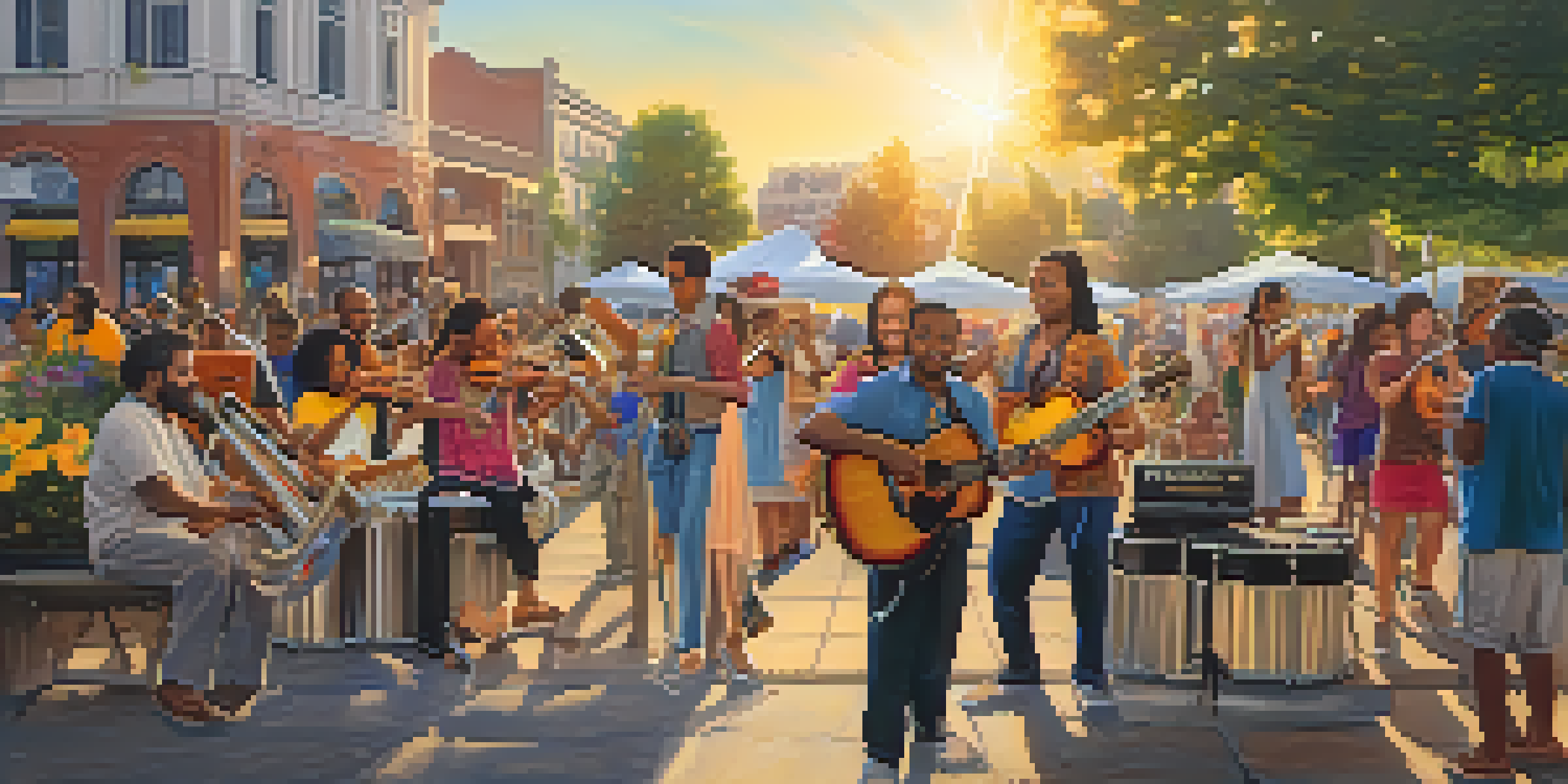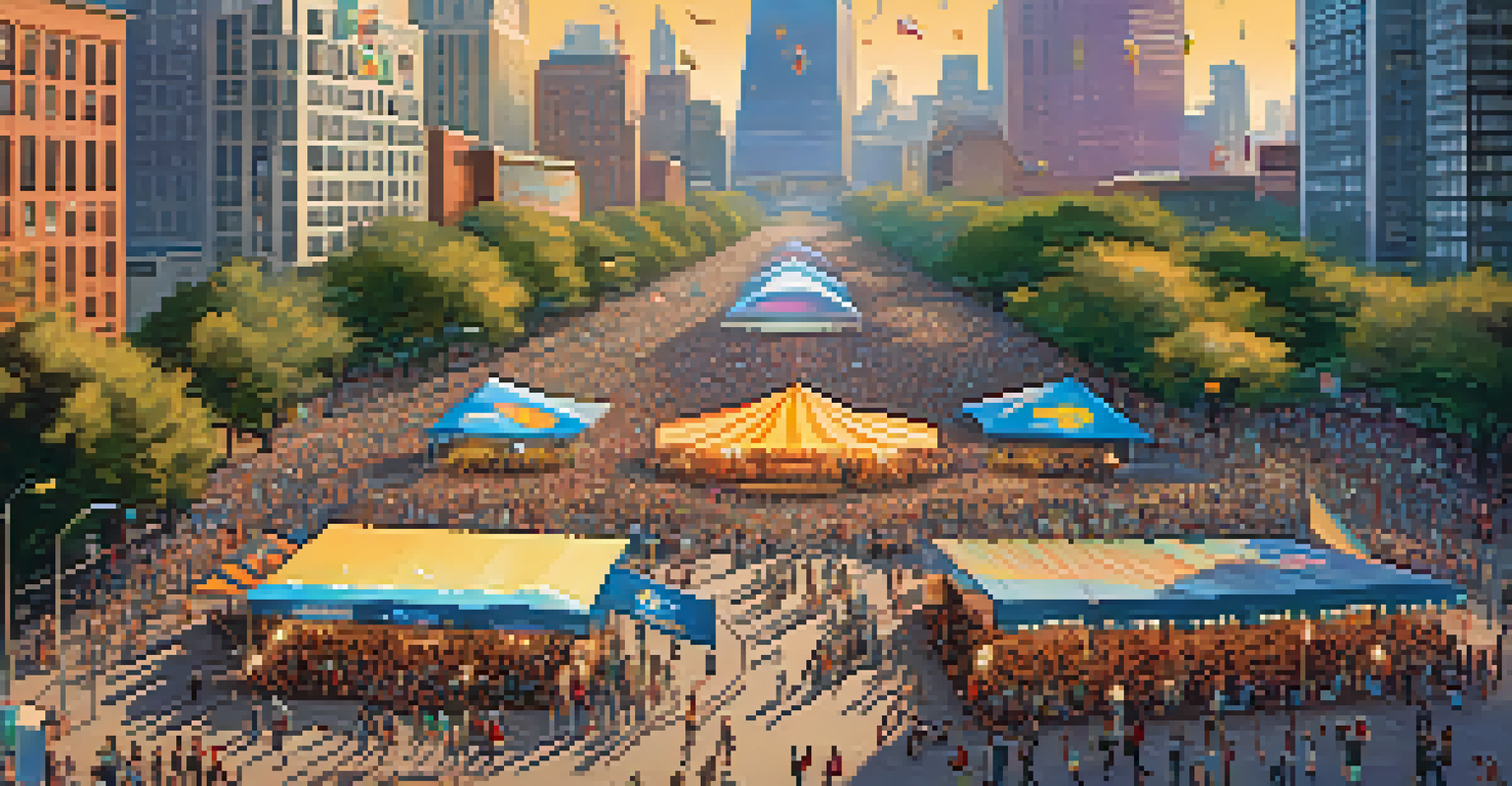The Sound of Change: Music's Role in Urban Transformation

Music as a Catalyst for Urban Renewal and Community Bonding
Music has long been a driving force behind urban renewal, often acting as a catalyst for change. Neighborhoods that embrace local music scenes can see a revitalization of public spaces, attracting new businesses and fostering community engagement. For instance, cities like Nashville have harnessed their musical heritage to rejuvenate areas, turning once-forgotten streets into vibrant hubs of activity.
Music can change the world because it can change people.
When communities come together through music, they form bonds that transcend cultural and socioeconomic barriers. Festivals and concerts create opportunities for residents to celebrate their diversity while promoting inclusivity. This sense of belonging can lead to increased civic pride, encouraging locals to invest in their neighborhoods and advocate for positive change.
Moreover, music serves as a powerful tool for storytelling, allowing communities to share their unique narratives. Through lyrics and melodies, local artists can highlight the struggles and triumphs of their neighborhoods, fostering a deeper understanding among residents. This shared narrative can inspire collective action, as people rally around common goals for their community.
The Role of Music in Economic Development and Job Creation
The music industry is not just about entertainment; it plays a significant role in economic development. Live performances, music festivals, and local venues create job opportunities, from event management to hospitality services. Cities that invest in their music scenes often see a ripple effect, where increased foot traffic leads to the growth of surrounding businesses.

For example, cities like Austin, Texas, have become known as music capitals, attracting tourists and new residents alike. The influx of visitors for events like South by Southwest (SXSW) stimulates local economies, benefiting hotels, restaurants, and retail shops. This symbiotic relationship between music and commerce showcases how artistic expression can fuel economic growth.
Music Drives Urban Renewal
Music acts as a catalyst for urban renewal by revitalizing neighborhoods and fostering community engagement.
Additionally, music education programs in schools can prepare the next generation for careers in the industry. By providing students with the skills needed to succeed in music-related fields, cities can cultivate a talent pool that keeps their music scenes vibrant and innovative. This investment in human capital not only supports individuals but also strengthens the community as a whole.
Urban Spaces Transformed: The Influence of Music Festivals
Music festivals have a unique ability to transform urban spaces, turning parks and streets into lively destinations. These events not only showcase local talent but also attract international artists, creating a melting pot of cultures and sounds. The energy generated during festivals can invigorate entire neighborhoods, leaving lasting impacts long after the music fades.
Without music, life would be a mistake.
Take Coachella, for instance; it has become synonymous with the California desert, drawing thousands of attendees each year. This influx of visitors not only boosts the local economy but also sparks interest in the region's art and culture. Such transformations can lead to permanent changes in how urban spaces are utilized and perceived by both locals and tourists.
Furthermore, festivals often inspire community involvement and volunteerism. Residents may come together to help organize events, fostering connections and a sense of ownership over their spaces. This collaborative spirit can lead to ongoing initiatives that keep the momentum of transformation alive, ensuring that the benefits of music festivals extend far beyond their duration.
Street Music: The Heartbeat of Urban Culture
Street musicians, or buskers, bring a unique vibrancy to urban environments, often becoming the heartbeat of their communities. Their presence adds to the cultural tapestry of cities, providing entertainment and a sense of spontaneity that enhances public spaces. These artists often reflect the local character, creating a soundtrack that resonates with both residents and visitors.
Moreover, street music can promote social connections, as people gather to enjoy performances. This communal experience encourages interaction among strangers, fostering a sense of belonging in often busy and impersonal urban settings. The simple act of stopping to listen can spark conversations, friendships, and a greater appreciation for the arts.
Economic Growth Through Music
The music industry contributes significantly to economic development by creating jobs and attracting tourism.
However, street musicians also face challenges, such as regulations and competition for space. Supporting local buskers through designated performance areas or community events can help ensure that their contributions are recognized and valued. By embracing street music, cities can enhance their cultural identity while providing artists with the opportunities they need to thrive.
The Emotional Connection: Music's Impact on Urban Well-Being
Music has a profound impact on emotional well-being, serving as a source of comfort and expression. In urban environments where stress and noise levels can be high, music offers an escape, allowing residents to connect with their emotions and find solace. Whether it's a favorite song playing on the radio or a live performance in the park, music can uplift spirits and foster resilience.
Research has shown that music can reduce anxiety and promote relaxation, making it an essential part of mental health initiatives in cities. Community programs that incorporate music therapy or group singing can create safe spaces for residents to share their experiences and heal together. This therapeutic aspect of music can be particularly beneficial in urban areas, where individuals often feel isolated despite being surrounded by others.
Additionally, music can serve as a form of activism, allowing individuals to express their frustrations and hopes for change. Songs that address social issues can inspire movements and unite people in their pursuit of justice. By amplifying these voices, cities can cultivate a culture of empathy and understanding, ultimately leading to a more harmonious urban environment.
Collaboration Between Artists and Local Governments
The collaboration between artists and local governments can create innovative solutions for urban challenges. When city officials recognize the value of music in community development, they can work alongside artists to implement programs that benefit residents. This partnership often leads to initiatives that promote cultural events, public art installations, and music education.
For instance, some cities have established grants to support local musicians and arts organizations, helping to fund projects that enrich the community. These initiatives not only elevate the local music scene but also contribute to the overall quality of life in urban areas. By investing in the arts, cities can attract talent and foster creativity, making them more vibrant and appealing places to live.
Community Bonds Through Festivals
Music festivals enhance community connections and inspire ongoing local initiatives, fostering a sense of belonging.
Furthermore, involving artists in urban planning discussions can lead to more inclusive and culturally relevant designs. Artists can provide valuable insights into how to create spaces that reflect the community's identity. This collaborative approach ensures that urban development is not only functional but also resonates with the people it serves.
Technology and Music's Evolving Role in Urban Life
As technology evolves, so does the role of music in urban life. Digital platforms and social media have transformed how artists share their work, allowing them to reach wider audiences than ever before. This accessibility enables local musicians to gain recognition and connect with fans, further enriching the urban cultural landscape.
Moreover, technology has changed how we experience music in public spaces. Innovations like sound installations and interactive performances invite residents to engage with their environment in new ways. These experiences can transform everyday locations into dynamic spaces where music and art converge, enhancing the overall urban experience.

However, with these advancements come challenges, such as the need for equitable access to technology. It's essential that cities prioritize inclusivity by providing resources for all artists, ensuring that the benefits of technological advancements are shared. By embracing both traditional and modern forms of music, urban areas can create a diverse and thriving cultural ecosystem.